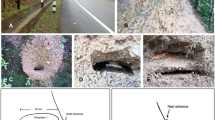Summary
Colonies of the ponerine Ophthalmopone berthoudi were collected throughout the year. The queen caste is absent. Dissection of large numbers of workers revealed that many of them (up to 100 in one nest) are inseminated and produce eggs. The ovaries are small and contain very few mature oocytes, indicating that there is a slow rate of egg-laying. Workers are produced throughout the year, and all are capable of becoming functional reproductives. However, only those that are sexually-attractive during the limited period of male activity become mated. Thus the percentages of mated laying workers (=gamergates) fluctuate seasonally (Fig. 2). Successive generations of gamergates do not overlap. Observation of nests in the field and in the laboratory indicated that gamergates were never active above ground. There is no aggression between them, and their numbers are not socially regulated. There are few interactions between gamergates and non-reproductive workers, and the former do not acquire more food during termite meals. The notion of parental oppression is undermined by the complete loss of the meen caste, while the nature of the breeding system of this ant leads to the prediction of low relatedness between nestmates.
Similar content being viewed by others
References
Alexander RD (1974) The evolution of social behavior. Annu Rev Ecol Syst 5:325–382
Berndt KP, Nitschmann J (1979) The physiology of reproduction in the Pharaoh's ant (Monomorium pharaonis L.) 2. The unmated queens. Insectes Soc 26:137–145
Bolton B (1974) A revision of the ponerine ant genus Plectroctena F. Smith. Bull Br Mus Nat Hist Entomol 30:311–338
Brandao CR (1983) Sequential ethograms along colony development of Odontomachus affinis Guerin (Hymenoptera, formicidae, Ponerinae). Insectes Soc 30:193–203
Buschinger A, Winter U (1978) Echte Arbeiterinnen, fertile Arbeiterinnen und sterile Wirtsweibchen in Völkern der dulotischen Ameise Harpagoxenus sublaevis (Nyl.) (Hym., Form.). Insectes Soc 25:63–78
Cagniant H (1979) La parthenogenese thelytoque et arrhenotoque chez la fourmi Cataglyphis cursor Fonse. (Hym. Form.) Cycle biologique en elevage des colonies avec reine et des colonies sans reine. Insectes Soc 26:51–60
Colombel P (1972a) Recherches sur la biologie et l'ethologie d'Odontomachus haematodes L. (Hym. Formicoidea, Poneridae). Biologie des ouvrieres. Insectes Soc 19:171–194
Colombel P (1972b) Recherches sur la biologie et l'ethologie d'Odontomachus haematodes L. (Hym. Form. Poneridae). La polygynie et sa regulation. Biol Gabonica 3–4:345–367
Crozier RH (1982) On Insects and Insects: twists and turns in our understanding of eusociality. In: Breed MD, Michener CD, Evans HE (eds) The biology of social insects. Westview, Boulder, pp 4–9 (Abstr)
Crozier RH, Pamilo P, Crozier YC (1984) Relatedness and microgeographic genetic variation in Rhytidoponera mayri, an Australian arid-zone ant. Behav Ecol Sociolbiol 15:143–150
Fletcher DJ, Blum MS (1981) Pheromonal control of dealation and oogenesis in virgin queen fire ants. Science 212:73–75
Fletcher DJ, Blum MS (1983) Regulation of queen number by workers in colonies of social insects. Science 219:312–314
Hamilton WD (1972) Altruism and related phenomena, mainly in social insects. Annu Rev Ecol Syst 3:193–232
Haskins CP (1970) Researchers in the biology and social behavior of primitive ants. In: Aronson L, Tobach E, Lehrman D, Rosenblatt J (eds) Development and evolution of behavior. Freeman, San Francisco, pp 355–388
Haskins CP, Whelden RM (1965) “Queenlessness”, worker sibship and colony vs population structure in the Formicid genus Rhytidoponera. Psyche 72:87–112
Haskins CP, Haskins EF (1980) Notes on female and worker survivorship in the archaic ant genus Myrmecia. Insectes Soc 27:345–350
Hölldobler B, Haskins CP (1977) Sexual calling behavior in primitive ants. Science 195:793–794
Hölldobler B, Taylor RW (1983) A behavioral study of the primitive ant Nothomyrmecia macrops Clark. Insectes Soc 30:384–401
Hölldobler B, Wilson EO (1983) Queen control in colonies of weaver ants (Hymenoptera: Formicidae). Ann Entomol Soc Am 76:235–238
Itow T, Kobayashi K, Kubota M, Ogata K, Imai HT, Crozier RH (1984) The reproductive cycle of the queenless ant Pristomyrmex pungens. Insectes Soc 31:87–102
Michener CD, Brothers DJ (1974) Were workers of eusocial Hymenoptera initially altruistic or oppressed? Proc Natl Acad Sci USA 71:671–674
Peeters C (1984) Social organization, breeding biology and the process of reproductive differentiation in Ophthalmopone berthoudi Forel, a ponerine ant. Unpublished PhD thesis, University of the Witwatersrand Johannesburg, South Africa
Peeters C, Crewe R (1984) Insemination controls the reproductive division of labour in a ponerine ant. Naturwissenschaften 71:50–51
Villet M, Peeters CP, Crewe RM (1984) The occurrence of a pygidial gland in four genera of ponerine ants (Hymenoptera: Formicidae). J G Entomol Soc 19:413–416
Ward PS (1981) Ecology and life history of the Rhytidoponera impressa group (Hymenoptera: Formicidae) II. Colony origin, seasonal cycles, and reproduction. Psyche 88:109–126
Ward PS (1983) Genetic relatedness and colony organization in a species complex of ponerine ants I. Phenotypic and genotypic composition of colonies. Behav Ecol Sociobiol 12:285–299
Ward PS, Taylor RW (1981) Allozyme variation, colony structure and genetic relatedness in the primitive ant Nothomyrmecia macrops Clark (Hymenoptera: Formicidae). J Aust Entomol Soc 20:177–183
Wheeler WM, Chapman JW (1922) The mating of Diacamma. Psyche 29:203–211
Wilson EO (1971) The insect societies. Harvard University Press, Cambridge
Author information
Authors and Affiliations
Rights and permissions
About this article
Cite this article
Peeters, C., Crewe, R. Worker reproduction in the ponerine ant Ophthalmopone berthoudi: an alternative form of eusocial organization. Behav Ecol Sociobiol 18, 29–37 (1985). https://doi.org/10.1007/BF00299235
Received:
Accepted:
Issue Date:
DOI: https://doi.org/10.1007/BF00299235




